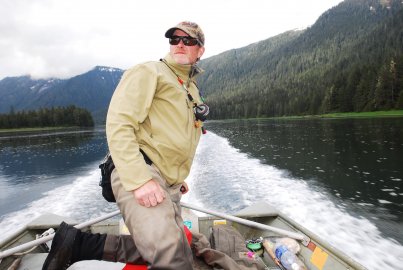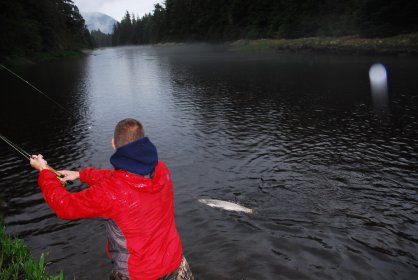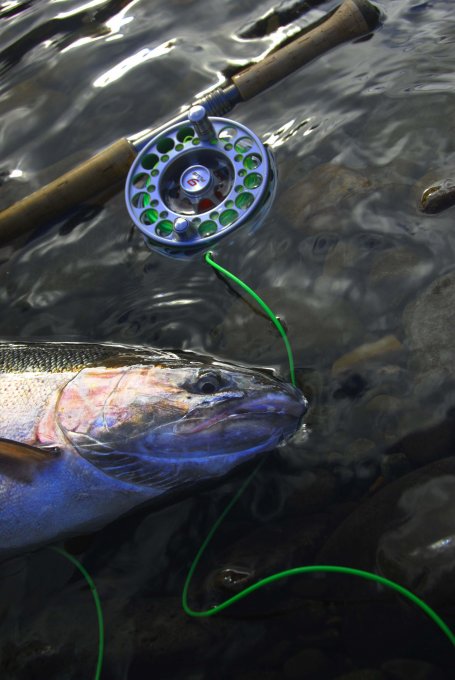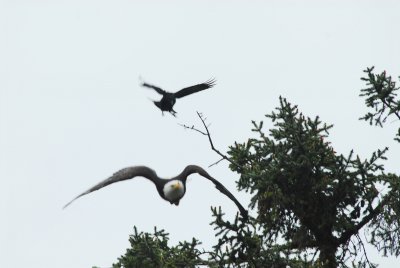NOTE: It’s winter steelhead season and few things get dedicated anglers more pumped than to think of fresh fish—chromers—pushing into Northwest streams. This isn’t a game of big numbers but even a few fish can change your life. Print this. Grab refreshment and a cigar. Enjoy.
Steelhead Dreams
It was one of those times early in life when every direction appeared as a dark ally, every prospect just a future downfall. Life had spiraled outside my control and I was afraid to step out of bed.
I appeared in court and said not guilty. What else was there to say? That the gun was unloaded and the girl was lying through her jealous, white-trash, trailer-park teeth? The college dean said he’d see me in his office. The judge said he’d see me in the morning. I posted bail and escaped to Alaska with visions of crimson and chrome swimming in my head.
During March I took odd jobs tendering herring, weighing roe, cutting the heads off blackcod, and painting masts. It was my first full spring season in Southeast and the change of scenery was as refreshing as those first few days of mid-April when winter seemed vulnerable at last and the warmth of the sun announced all could change, that the dour world might finally introduce itself as lush, attractive and fresh. Soon, against my promise, I declined work. A quest for steelhead—those brawny, elusive, addictive sea-run rainbow trout—began.
It happened that my friend, Chris, had a boatload of time on his hands, too. And he had a boat. In Southeast a boat means freedom. With the seine season resting a couple months away we found that Chris, who I called Klondike, could stretch the leash as long as he brought home to his wife an occasional load of firewood and a couple sweet spruce grouse.
It proved a favorable agreement and at every chance we loaded that 16-foot Lund to the gunnells with flyrods, a tent, cases of Rainier, cheap sleeping bags, gas tanks, and half-gallons of Canadian Hunter. We’d check the tides, say goodbye to the cruel world, declare a return date, pop tops, and head out across the sounds and straits knowing if all went well the weather and waves might impede our return.
Unfortunately, we found steelhead scarce that spring. During a two-week foray, Klondike landed a single fish, a chrome-bright hen of eight pounds, but that was it. As the season moved into late-April and its prime, water conditions deteriorated and there grew a sensation that we might throw 10,000 more casts or fish another 10,000 years without a take. The woodpile reached epic proportions and we put a dent in the grouse population.
Steelhead are strange fish, extremely secretive and difficult to catch. Mostly, it’s about locating them. Some years they return to the streams where they are expected. Other years, as Klondike and I quickly learned, they may not return at all for reasons fish managers don’t fully understand. Killer whales and sharks? Drift-nets? Poor ocean forage conditions? Pollution? Acts of god? It’s a great mystery of the high-seas. More so than any other fish, steelhead make anglers pay for their capture in physical pain and mental anguish.When it comes right down to it chasing a fish that rarely feeds in freshwater, is never found in abundance, and demands pursuit when the weather and river conditions are at their least predictable worst, borders on ridiculous. For an impatient angler, that torture manifests in the resignation of a day; by declining future invitations to fish the coastal streams; by casing the eight-weight rod in favor of a delicate wand and the appeal of eager inland trout and other less-burdensome species.
Yet, behind every hard-core trip to the river, announced in every unwelcomed cast, driven into the brain by frozen fingers, feet and cheeks, is the notion that some day, which will be the best day of your life, steelhead will arrive in masses and they will be happy fish, willing to eat the swinging fly and recompense for their delinquent behavior. It will be a day to serve as remedy, after which anglers expect to slip quietly, contentedly into the mainstream, giving full-spirit to their families and work, picking up those distant relationships outside fishing, relinquishing those ceaseless steelhead dreams.
Unfortunately, that notion is horseshit. Bet the farm on this one because, like any addict, even mildly successful steelhead anglers steadily rid themselves of obligation, giving up chunks of their lives beyond fishing to chase their rush, burning more money and time and what remained of their social reputations for an opportunity to land more of those incredibly strong, amazingly acrobatic sea-run rainbows. In the pursuit of those fish college educations are lost, jobs forfeited, wives abandoned, soccer games left unattended, court orders ignored. That’s just the way it is.
One day, when the sun shone bright and the rivers dropped into shape, and with our determination reining supreme, we loaded the boat and headed south down Wrangell Narrows, directing the bow beyond floating kelp heads, toward unsuspecting seagulls, around deadheads and rocks exposed by low tide. We wanted to catch the largest steelhead around and we aimed for a medium-sized stream known to produce fish ranging between six and 15 pounds.
We rode in on the high tide, slid the skiff into the tidal grass and lugged our tent beyond the edge of the forest. Thinking back, looking back on that evening, it occurs to me that catalogue descriptions of two-man tents don’t apply to grown men and their fishing gear. Especially when juiced on Canadian Hunter. We spent half the night engaged in a turf war, pushing rod tubes, waders, boots and cookware back and forth. The battle threatened violence when someone got smacked in the nose and a boot sailed out of the tent, into the rain.
We rose early and tromped up a bear trail paralleling the river and we didn’t go far before rigging the rods. On the narrow streams in Southeast anglers find appealing water around every bend.
We tested several prime pools with green butt skunks, egg-sucking leeches and Skykomish sunrises. But nary a take. We continued the process at each pool, casting, mending, drifting the fly, swinging the fly, stripping the line. Repeating the process over and over and over and over. Each cast was loaded with devotion and rejected without regret. In the afternoon Klondike said there was one more good hole upstream, a vertical cascade leading to a deep plunge, followed by a slick run and a shallow tailout, accentuated by several oversized, midstream boulders. Classic steelhead water.
We climbed a high bank above the stream, sat for a smoke and peered into the run. Shafts of light carved through the forest mist and spread out over the river like a translucent fan.
Klondike, a good father, asked, “What were you doing with a loaded gun, threatening a girl?” His brother, who I ran with down south in Montana, had given him a sketch.
It was a conversation I’d expected beginning the day of arrival, from the moment Klondike picked me up in a pouring rain at the Petersburg airport. It was a subject I could mostly explain, but it was a subject, I understood, that each person would interpret differently and I’d never know again if a discussion ended in total belief.
“We went target shooting up Rock Creek with my twenty-two,” I explained. “That was the mistake, Chris. She was trouble from the start and I knew it. I wasn’t doing well in school. The professors tore me up in class. My money ran out. Dude, was a knockout and I needed her to love me.”
I could see through the glare to the bottom of the river in several places, but there remained dark patches throughout the run, dark enough to conceal a steelhead. I took a pull from the warming flask. Then, for a moment—just long enough to say I saw something, but not long enough to keep from questioning my eyes—an elongated shape slipped from the shadow of a large boulder to the far edge of the run where it was briefly outlined by tan, sunlit bottom rocks. And then it was back to the big rock and hidden.
“Your crazy,” Klondike pronounced. “Why are you falling in love with a girl like that? Can’t you can do better? What, do you want to spend your life in jail? You wouldn’t be able to fish.”
“Chris,” I replied, acknowledging a distinct threat and a hint of superiority in his tone. “The gun was unloaded. We drank a lot. Whiskey and beer. It was great escape. She went to the kitchen for more. Her sister rushed the couch. When she came back with beers her sister was wrapped around me, kissing me. I thought I was looking in a mirror. Total twins. In that blurred state, I couldn’t differentiate. One in the same. And I chose the wrong one. She screamed, ‘What are you doing?’ I said, ‘I thought it was you.’ I got slapped. It was all about sibling rivalry, I guess.
“Then she said, ‘get out of my mother’s house.’ I told her I couldn’t drive. She called the police. I called her a bitch. I never threatened her. The gun was unloaded, in the car, stuffed under the driver’s seat. It became perfectly clear how evil she could be. I panicked. There were five patrol cars waiting at the Van Buren exit. They had guns drawn when they got to the car. They said, ‘Where’s the loaded gun!’ I said, ‘I thought you might ask something like that.’”
Reviving that situation was disconcerting and it emphasized that all was not resolved, that in three months my ass would be back in Missoula, in court, to negotiate with the country prosecutor and accept a penalty.
I looked past the river into the forest. Beyond the trees existed more islands, hundreds of unexplored steelhead streams, and the promise of possibility and mystery. It occurred to me that a guy could spend his life researching those streams, sleeping in forest service A-frames, camping on the beaches, living mostly off the forest and sea, documenting the existence and depth of the area’s wild steelhead runs. Who could possibly call that a lost life? For a moment I thought I might sprout wings. And then reality caught me by the back of my jersey.
I could escape the situation via distance and piscatorial distraction, but before long reality and accountability would come due. But it wasn’t due now, not on this stream.
“Klondike,” I announced, shaking a finger toward the stream. “There’s a — big – fat –- steelhead — sitting right next to that rock.”
The fish moved to the fly on the first cast but it didn’t eat. On the second swing I saw a shape rise high in the column, I detected the white flash of its mouth, I saw the blood-red crimson slash as it turned, and I fully understood the pulse in my rod. When the fish’s head parted the water and slapped the surface with the effect of a snowshovel, my heart beat toward overcapacity. This was a mammoth of a steelhead, the kind of fish for which an angler could cast away a lifetime without assurance.
At that moment there seemed nothing nearly as important as the landing of that great fish. Every ounce of concentration, every electric spark in the brain, every twine of tendon and muscle, every stitch of my being was fully dedicated to the task. And for a moment nothing in the world –- not an education, not society’s criticism, not the need for affection and self-worth and identity, not the stock market, not even those delinquent checks and the impending court date seemed worth a darn. Space is deep, unfathomable. At that moment I was riding a comet, 500,000 light years away from Earth with one giant steelhead busting my ass. Time travel delivered, minus the jetlag. I recalled a favorite quote: All men are equal before fish.
Southeast’s streams run off-color with a tea-like tint. They are difficult to wade even in prime condition, and this river was no exception. In addition, Southeast’s streams are constructed with rock slabs stacked one atop the other. That construction forms ledges that drop straight to the bottom of deep pools. To wade across those streams is to grasp blind faith by the balls.
I can recall today, the sensation of stepping off a skyscraper, not knowing how far I would fall. And in the instant that my leading foot hung in suspension it was determined that I would swim the river, with rod held high and tension retained, in order to land this fish. Fortunately, my foot touched bottom before water reached the lip of my waders and I crossed with no further significance.
But it wasn’t a fast process and now the fish was far downstream challenging the lip of a rapid where success and failure would be measured in feet –- if the fish continued another yard on its downstream path into that speedy rapid, I’d be spooled.
Klondike implored, “Well, you better get going.”
The big fish held in tender flow and I retrieved line until a massive blowdown impeded downstream progress. I renewed vows and picked my way across the river to the near side, again avoiding the death-ledge.
Now I carried the upper hand. The fish had tired. It held behind a large midstream boulder, having moved upstream from the lip. The rod didn’t pulse as often, the line was retrieved and, for as great as the fish appeared, it politely rolled to its side and swept into the sand beach with minor complaint. Chris took the fish by the tail and held it in the gentle flow.
“It’s f’in huge,” he hissed. “It’s a giant steelhead.”
We stretched a tape from the tip of that steelhead’s nose to tip of its square tail. Forty-two inches. A forty-two inch buck steelhead from Southeast Alaska. We held the fish in mild current, Klondike supporting its head and belly, my right hand wrapped around its tail, each of us burning its image into our skulls. When my entire arm shook with its gyration, I released the grip.
That spring, Chris and I fished many streams brimming with solitude and mystery. The steelhead finally arrived and we caught them large and small, chrome-bright and the color of crimson. One day produced 34 takes and 12 fish landed. Another time, a bright 10-pound hen broke free from Chris’ grip and scooted to the bottom of a deep, dark hole towing Klondike’s rod into oblivion. We never found another 20-pounder, but that didn’t matter.
I realize now the effort and dedication required to land any steelhead, not just a fish exceeding the 20-pound mark. And I understand fully the appeal of steelhead, any size, wherever they are found. Each is a treasure, a miracle to have survived the perils of rivers, dams, nets and the predators of the high-seas. However, for reasons I may not even be entirely aware of, it’s my opinion that no place offers the quintessential experience that a late-winter steelhead trip to Southeast provides.
For me, steelhead always will be regarded as a coastal fish, indelibly tied to the temperate rainforests and the moss covered logs, and the tea-colored streams. When fishing the perfect steelhead stream I will find an old, weathered A-frame cabin at its mouth. Bears, gulls, otters and ravens will stalk the mudflats where the stream mixes to salt. Upstream, dark, timbered forests will touch the river’s edge and Sitka blacktailed deer will peer out from their devils club and alder patch hiding places. Bald eagles will survey my progress, ancient bear trails will lead upstream. The rains will come, the rivers will run high and fast and unfishable for weeks and a depression will grow inside me like mold. And then the rivers will fall and my spirit will rise and life will again appear as worth living. I’ll steal away to the forest. I’ll stand next to a narrow, coastal stream with a flyrod in hand waiting to get bit, firmly entrenched in this steelhead dream.





